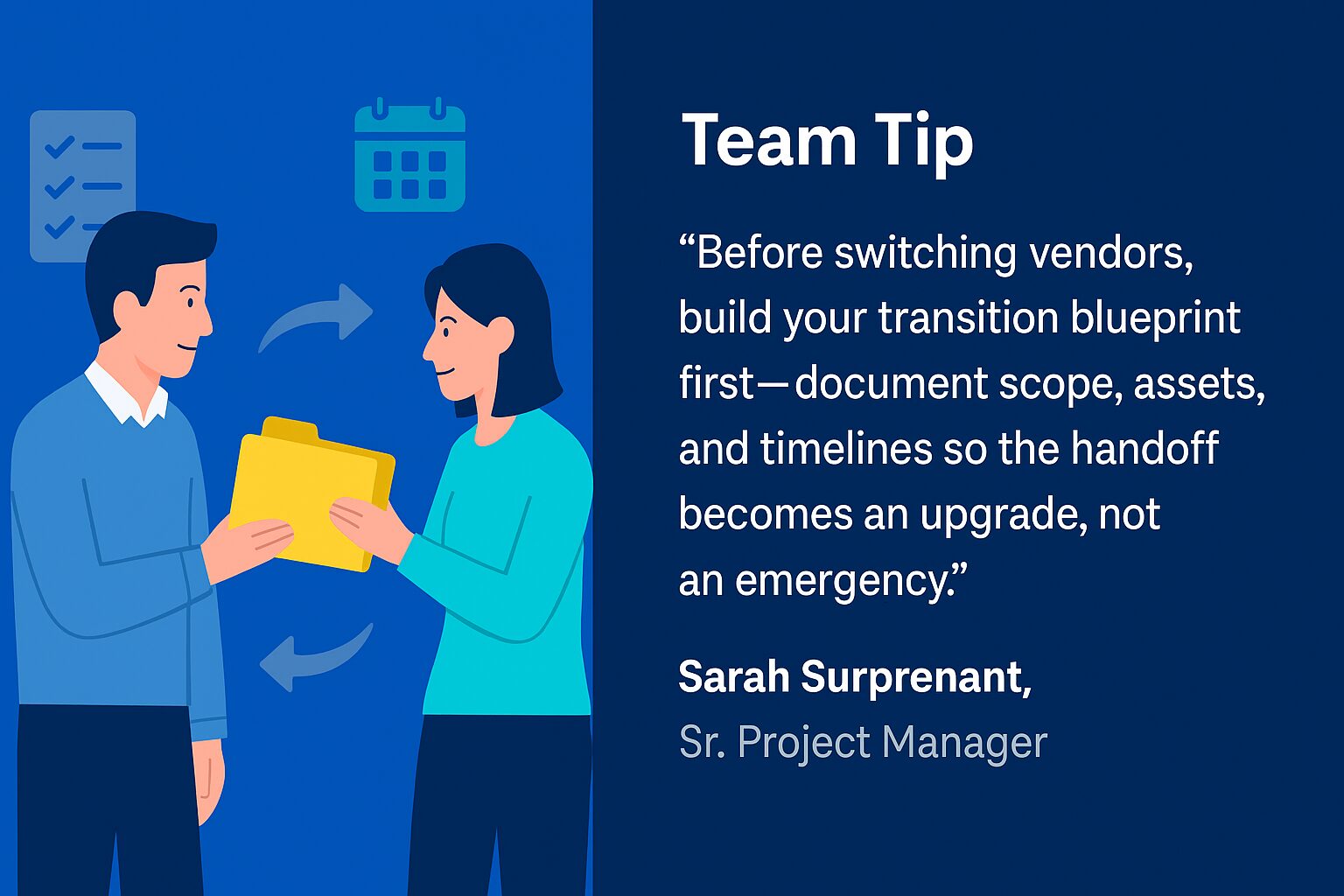TL;DR:
-
Watch for Warning Signs of a Failing Partnership: If response times drag, strategic insight disappears, or execution causes more problems than it solves, your vendor may be holding you back.
-
Common Red Flags to Look Out For:
-
Delayed or unclear communication
-
Lack of SEO, UX, or optimization support
-
Confusing billing or project tracking
-
Frequent bugs, performance issues, or broken features
-
Capabilities that no longer match your evolving needs
-
-
Audit Before You Act: Document what’s broken and what your next vendor must do better. Capture support gaps, tech frustrations, and performance pain points to guide the transition.
-
Secure Control of All Key Assets: Before ending your current vendor relationship, ensure you have full access to your CMS, hosting, analytics, DNS, and design files and reset all credentials.
-
Plan a Clear, Collaborative Transition: A 90-day onboarding plan with the right partner (like 3 Media Web) ensures stability, fixes key issues fast, and sets up better workflows, support, and performance for the long haul.
Most marketing managers start with high hopes when hiring a website vendor. You expect a responsive partner who understands your goals, supports your team, and helps your site evolve with the business. But as time passes, something starts to shift. Requests take too long. Strategic input is minimal. Communication drops off. And you’re left wondering: is this partnership still working?
If managing your website feels harder than it should, and your vendor’s more of a blocker than a booster, it might be time to move on. But switching vendors comes with risk.
This post outlines common red flags and how to make a clean transition without losing momentum.
Why Web Vendor Fit Matters More Than You Think
Your website isn’t a one-time project. It’s a living, lead-generating, campaign-driving engine that needs ongoing care. And in B2B manufacturing, it must support complex messaging, evolving offers, and long sales cycles.
If your vendor can’t keep up, your website becomes a liability slowing down launches, harming your brand perception, or blocking opportunities for conversion rate optimization.
5 Red Flags Your Current Vendor Relationship Is Failing
Watch for these warning signs that your web partner may no longer be the right fit.
1. Slow or Inconsistent Response Times
You’re submitting tickets or emails, but hearing nothing back for days or longer. Campaign timelines suffer, internal teams get frustrated, and your roadmap stalls.
- Missed or delayed deliverables
- Vague timelines for basic updates
- No escalation process for urgent issues
2. Lack of Strategic Support
You’re getting task execution, not strategic thinking. There’s no proactive insight into how your site can perform better or what changes could support your goals.
- No regular check-ins or performance reviews
- No input on SEO, UX, or optimization opportunities
- You’re the only one flagging problems
3. Opaque Processes and Billing
You’re unclear on how requests are tracked, how hours are used, or what’s included in your agreement. You get unexpected invoices or unclear project status updates.
- No shared project tracker or ticketing system
- Surprise costs without justification
- Limited visibility into hours used or budget remaining
4. Poor Technical Execution
Pages break. Forms stop working. Updates create new issues. Instead of solving problems, the vendor creates more of them and your team is stuck cleaning up.
- Frequent bugs or performance issues
- Inconsistent mobile experience
- Trouble maintaining accessibility or site speed
5. You’ve Outgrown Their Capabilities
What worked when your company was smaller no longer serves your needs. You need better integration support, analytics, or faster web design and development but the vendor isn’t evolving with you.
- Limited CMS or tech stack expertise
- No roadmap for future improvements
How to Make the Switch Smoothly
Once you’ve decided it’s time to move on, switching vendors doesn’t have to mean chaos. With planning and the right partner, you can make the transition with minimal disruption.

Step 1: Audit What’s Working and What’s Not
Document current gaps, frustrations, and wish-list improvements. Include:
- Website support response time
- Ease of updating content
- Current performance (speed, SEO, lead generation)
- Integration issues (CRM, forms, analytics)
This will clarify what your new partner must deliver and help them onboard effectively.
Step 2: Secure Site Access and Assets
Before ending your current contract, make sure you have full administrative access to:
- CMS and hosting accounts
- Domain registrar and DNS settings
- Google Analytics, Tag Manager, and other tools
- Design files, templates, and brand assets
Pro tip: Change all credentials once access is transitioned.
Step 3: Choose a Partner That Aligns with Your Need
Look for an agency that:
- Understands B2B manufacturing marketing
- Offers both strategic input and day-to-day website support
- Works collaboratively and transparently
- Can handle integrations, performance, paid media management, and SEO
- Has clear onboarding, intake, and tracking processes
Step 4: Create a 90-Day Transition Plan
Work with your new agency to prioritize:
- Fixing known issues
- Migrating or documenting CMS structure
- Reviewing design systems or templates
- Setting up recurring requests or campaign workflows
- Auditing accessibility and performance for a fresh start
How 3 Media Web Can Help
At 3 Media Web, we’ve helped dozens of marketers make the switch from underperforming vendors to strategic digital partnerships.
Our onboarding process includes:
- A comprehensive site audit
- Transition planning and CMS access review
- Setup of dashboards, tracking tools, and task management
- Ongoing collaboration and regular performance check-ins
- Support across web design and development, SEO, conversion optimization, and more
Whether you need a one-time audit or long-term support, we’re ready to step in and help your marketing team get more from your website.
